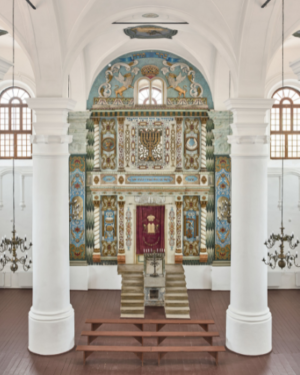Books
Non-fiction
Yearning for Sacred Spaces
Synagogues: Marvels of Judaism
By Leyla Uluhanli (Rizzoli)

Each section of Synagogues, which is organized geographically, opens with an essay about the local Jewish community and the influence of regional arts, culture and customs on synagogue design. Painted floral medallions and hanging lamps that adorn the Yu Aw Synagogue in Herat, Afghanistan, built in the 14th century and currently used as a school for local children, reflect the splendor of nearby mosques. The Great Synagogue of Wlodawa in Poland, now part of a museum, was built in the grand Baroque style common among local churches in the 18th century. Its elaborate painted and gilded plasterwork ark was installed in 1936 after a fire destroyed the previous one. It is one of the best-preserved large synagogues in Poland.

Other featured synagogues remain active houses of worship, such as The Fannie and Maxwell Abbell Synagogue at Hadassah Hospital Ein Kerem in Jerusalem, a sacred space gloriously lit by Marc Chagall’s stained-glass windows depicting the 12 tribes of Israel. Then there is the light-filled Gates of the Grove (Shaarey Pardes) sanctuary at the Jewish Center of the Hamptons (shown on the cover of this issue), built in 1989. Architect Norman Jaffe’s cedar interior is a reference to the once-prevalent wooden synagogues of Eastern Europe, and the distinctive angling and staggering of the woodwork, according to Jaffe, is meant to remind worshipers of a Jew “bent in prayer.”
“Each of these historic buildings has been hallowed by spiritual journeys, communal prayers, meditations, and songs,” photographer Judy Glickman Lauder writes in the foreword, “by candles kindled, Torah portions chanted, rituals enacted, and milestones marked.”
Synagogues takes readers on a journey, too, a pilgrimage of distinct Jewish spaces near and far and the tenacious threads of history, faith and community that unite them all.










 Facebook
Facebook Instagram
Instagram Twitter
Twitter
Leave a Reply